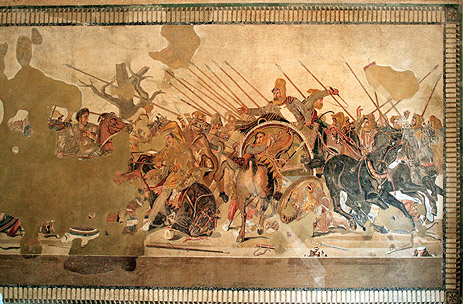Image Resource Bank
Image Gallery |  1 of 15
1 of 15 
Alexander the Great Mosaic
This mosaic floor from Roman Pompeii shows how ancient artists might interpret contemporary circumstances by referring to events that were already ancient in their own time. It depicts a battle between Alexander the Great, shown as young, unhelmeted, and aggressive on a rearing charger, and the Achaemenid Persian king Darius III, shown as graying, alarmed, and looming over a horse’s hindquarters while his charioteer lashes his team in retreat.
The mosaic was made in the first century BCE, when the Roman Empire was in the early stages of a long standoff with the Parthian Empire of Persia, a confrontation that played out in the same territories where Alexander had been triumphant 400 years earlier. Unlike the artist of the piece illustrated in image 2, the maker of this mosaic showed accurate historical knowledge in his portrayal of Persian attire and arms.
Name: Alexander the Great Mosaic
Material: Tesserae (Tiny glass cubes)
Size:
Width: 5.82 m (19 ft)
Height: 3.13 m (10 ft 3 in)
Date: ca. 100 BCE
Place of Origin: Floor of the House of the Faun, Pompeii, Italy
Location: Naples National Archaeological Museum, Italy
Source and Registration#: Wikimedia Commons. Link to resource![]() (accessed August 17, 2009).
(accessed August 17, 2009).
Attribution: Work of Magrippa
Official License: Licensed by GNU Free Documentation License, Version 1.2![]() or later version published by the Free Software Foundation. Wikimedia Commons. (accessed August 17, 2009).
or later version published by the Free Software Foundation. Wikimedia Commons. (accessed August 17, 2009).

 Matthew W. Stolper
Matthew W. Stolper
Professor of Assyriology and the John A. Wilson Professor of Oriental Studies




